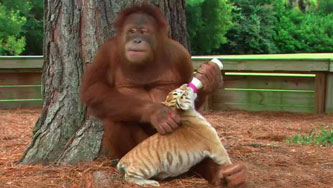
It is a most amazing picture --enough to change commonly held human notions about other species' capacity to feel empathy. Bending its two front legs, a young cow strives to have a better look of a toddler in a squatting position. The inquisitiveness is reciprocal. Then only recently did a baby elephant in Thailand came forward to rescue a man it thought was drowning. At home in an animal park at Moulvi Bazar a primate couple started looking after an abandoned kitten with the female breast-feeding the adopted small feline. Add to this yet another revealing fact concerning fellow feeling believed until recently was confined only to human beings and primates. This is the voluntary sacrifice for other members of a group. In order to help others to get foods, magpies simply go hungry. When they bend branch with their collective weight, others in the flock can reach for fruits but they themselves have no chance of getting near the fruits. A study was conducted in controlled circumstances to this effect. If they find that their help is of no use for others, they stop bending the branches.
These stories really throw challenges to human understanding of animal capacity for emotion, empathy and intelligence. In the case of magpies, both the sacrificial mentality and intelligence of a superior type is amply displayed. In case of a lioness and a baby oryx, the motherly attachment for the calf has been interpreted as a kind of mental sickness on the part of the former. Who can be so sure? It may as well be that inadequate understanding of the phenomenon is responsible for such a biased view. Given the opportunity, the inter-species relations can transform into something never experienced before. Inter-species motherly affection and friendship are heavenly, indeed.
Dogs and horses have become trusted companions of man ever since the dawn of civilisation. But cows, notwithstanding their greater contribution to all-round human well-being, have never become a steadfast companion like dogs and horses. One of the earliest domesticated animals, cows are drab, slow and, as it appears, quite vacuous at times. Also their size does not help the cause. When they grow up to their near full or full size, they cannot play like dogs or give company like a horse. They need to eat and chew the half-eaten straws or grass at leisure time. But still they demonstrate their affability and even joys when the master or keeper approaches them in order to take them out of their shed or enclosure to grazing field or feeding fences. Surely they are not good at showing their faithfulness to their masters.
Sarat Chandra Chattopadhya's Mahesh provides a rebuff to this notion. Surely, a cow will not wait for its master at an airport like the dog did at a Russian airport from where its master flew never to return back. But the dog could not be taken away from the airport. It waited for years in the hope its master would return. First, it refused to eat any food offered to it by the airport staff. But gradually it started eating their food and yet never to leave the airport. Hardly a man would do so for his companion. A cow's faithfulness may not as well match the devotion of the canine kind. But when a pampered cow or bull is sold under compulsion, the way it reacts is enough to indicate that it feels the pangs of separation acutely. It becomes aggressive to strangers who try to take it away. If possible, it breaks free from the ropes or poles to run towards what it has known its home for long.
Sure enough, dogs and cats have more challenging and savouring records on this count. When they are left or somehow taken to distant places, they find their ways --at times through a maze of traffic --to their masters' abode hundreds of miles away. There are stories of happy reunion like this. Cows are not known to have ventured on such expeditions. This does not disqualify them to reciprocate tender feelings. They even moo to express their need. Most often they would try to lick a keeper's body to express their liking. When the underside of their throat is gently scratched, they enjoy the tender touch with their eyes shut.
It is said, saintly people can tame the fiercest of animals. Because they do not harbour any hatred for any species, no animal or creature also attacks them. In the National Geographic Channel, there is a man who is not even a monk like that of Thailand's temple where tigers are raised, but he surely plays with tigers, lions, wolves and even hyenas. They respond to his call and express their love for him in no uncertain terms. In a zoo, an ultimate test of such friendship was taken when a leopard from some distance started running to attack one of the zookeepers near the boundary wall. A tiger's keen eyes did not miss it and he jumped at the right time to thwart the attack and save the man. There is perhaps no need for further proof of the inter-species bond that goes from strength to strength when properly cultivated.
© 2025 - All Rights with The Financial Express
